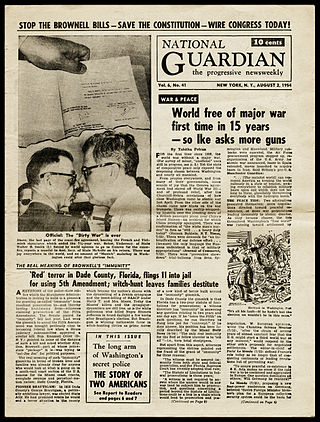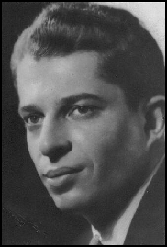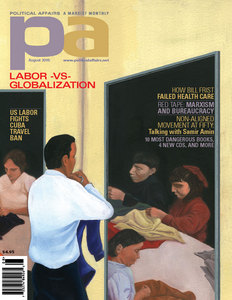Related Research Articles

The Monthly Review is an independent socialist magazine published monthly in New York City. Established in 1949, the publication is the longest continuously published socialist magazine in the United States.

Lorraine Vivian Hansberry was an American playwright and writer. She was the first African-American female author to have a play performed on Broadway. Her best-known work, the play A Raisin in the Sun, highlights the lives of black Americans in Chicago living under racial segregation. The title of the play was taken from the poem "Harlem" by Langston Hughes: "What happens to a dream deferred? Does it dry up like a raisin in the sun?" At the age of 29, she won the New York Drama Critics' Circle Award — making her the first African-American dramatist, the fifth woman, and the youngest playwright to do so. Hansberry's family had struggled against segregation, challenging a restrictive covenant in the 1940 U.S. Supreme Court case Hansberry v. Lee.

Usonia is a term that was used by the American architect Frank Lloyd Wright to refer to the United States in general, and more specifically to his vision for the landscape of the country, including the planning of cities and the architecture of buildings. Wright proposed the use of the adjective Usonian to describe the particular New World character of the American landscape as distinct and free of previous architectural conventions.

Herbert Aptheker was an American Marxist historian and political activist. He wrote more than 50 books, mostly in the fields of African-American history and general U.S. history, most notably, American Negro Slave Revolts (1943), a classic in the field. He also compiled the 7-volume Documentary History of the Negro People (1951–1994). In addition, he compiled a wide variety of primary documents supporting study of African-American history. He was the literary executor for W. E. B. Du Bois.
John Howard Lawson was an American writer, specializing in plays and screenplays. After starting with plays for theaters in New York City, he worked in Hollywood on writing for films. He was the first president of the Writers Guild of America, West after the Screen Writers Guild divided into two regional organizations.

The National Guardian, later known as The Guardian, was a left-wing independent weekly newspaper established in 1948 in New York City. The paper was founded by James Aronson, Cedric Belfrage and John T. McManus in connection with the 1948 Presidential campaign of Henry A. Wallace under the Progressive Party banner. Although independent and often critical of all political parties, the National Guardian is thought to have been initially close to the ideological orbit of the pro-Moscow Communist Party USA, but this suspected association quickly broke down in the course of several years.

Albert Maltz was an American playwright, fiction writer and screenwriter. He was one of the Hollywood Ten who were jailed in 1950 for their 1947 refusal to testify before the US Congress about their involvement with the Communist Party USA. They and many other US entertainment industry figures were subsequently blacklisted, which denied Maltz employment in the industry for many years.
New Politics is an independent socialist journal founded in 1961 and still published in the United States today. While it is inclusive of articles from a variety of left-of-center positions, the publication is historically associated with a "Neither Washington Nor Moscow!" Third Camp, democratic Marxist perspective, placing it typically to the left of the social democratic views in the journal Dissent.

Gabriel Dell was an American actor and one of the members of what came to be known as the Dead End Kids, then later the East Side Kids and finally The Bowery Boys.

Political Affairs Magazine was a monthly Marxist publication, originally published in print and later online only. It aimed to provide an analysis of events from a working class point of view. The magazine was a publication of the Communist Party USA and was founded in 1944 upon the closure of its predecessor, The Communist, which was founded in 1927. Well-known editors of Political Affairs Magazine included V. J. Jerome, Gus Hall, Hyman Lumer, Herbert Aptheker, Gerald Horne, and Joe Sims. Other editors included Max Weiss. In 2016, the magazine stopped publishing articles and merged with People's World.
The American Institute of Mining, Metallurgical, and Petroleum Engineers (AIME) is a professional association for mining and metallurgy, with over 145,000 members. The association was founded in 1871 by 22 mining engineers in Wilkes-Barre, Pennsylvania, and was one of the first national engineering societies in the country.

New Masses (1926–1948) was an American Marxist magazine closely associated with the Communist Party USA (CPUSA). It was the successor to both The Masses (1911–1917) and The Liberator (1918–1924). New Masses was later merged into Masses & Mainstream (1948–1963).

During the ten decades since its establishment in 1919, the Communist Party USA produced or inspired a vast array of newspapers and magazines in the English language.
The Committee for Cultural Freedom (CCF) was an American political organization active from 1939 to 1951 which advocated opposition to the totalitarianism of both the Soviet Union and Nazi Germany in foreign affairs, and promoted pro-democratic reforms in public and private institutions domestically. Co-founded by influential philosopher and educator John Dewey and the anti-Soviet Marxist academic Sidney Hook, it was reorganized in January 1951 into the American Committee for Cultural Freedom.
A Raisin in the Sun is a play by Lorraine Hansberry that debuted on Broadway in 1959. The title comes from the poem "Harlem" by Langston Hughes. The story tells of a black family's experiences in south Chicago, as they attempt to improve their financial circumstances with an insurance payout following the death of the father, and deals with matters of housing discrimination, racism, and assimilation. The New York Drama Critics' Circle named it the best play of 1959, and in recent years publications such as The Independent and Time Out have listed it among the best plays ever written.
Lloyd Louis Brown was an American labor organizer, Communist Party activist, journalist, novelist, friend and editorial companion of Paul Robeson's, and a Robeson biographer.

Freedom was a monthly newspaper focused on African-American issues published from 1950 to 1955. The publication was associated primarily with the internationally renowned singer, actor and then officially disfavored activist Paul Robeson, whose column, with his photograph, ran on most of its front pages. Freedom's motto was: "Where one is enslaved, all are in chains!" The newspaper has been described as "the most visible African American Left cultural institution during the early 1950s." In another characterization, "Freedom paper was basically an attempt by a small group of black activists, most of them Communists, to provide Robeson with a base in Harlem and a means of reaching his public... The paper offered more coverage of the labor movement than nearly any other publication, particularly of the left-led unions that were expelled from the CIO in the late 1940s... [It] encouraged its African American readership to identify its struggles with anti-colonial movements in Africa, Asia, and the Caribbean. Freedom gave extensive publicity to... the struggle against apartheid."

Louis Everett Burnham was an African-American activist and journalist. From his college days, and continuing through adulthood, he was involved in activities emphasizing racial equality, through various left-wing organizations, campaigns and publications in both the northern and southern United States, particularly in New York City and Birmingham, Alabama.
Sidney Finkelstein (1909–1974) was an American cultural critic with wide-ranging interests in literature, music and fine arts, which he analyzed from a Marxist perspective. His area of particular expertise was popular music: its history, and the relationship between music and society. His best-known books include Jazz: A People's Music (1948), How Music Expresses Ideas (1952), and Composer and Nation (1960). Along with Charles Seeger, Finkelstein is considered "one of two American Marxist musical theoreticians of consequence." He has also been compared to British jazz writer "Francis Newton," pseudonym for British Marxist historian Eric Hobsbawn.
Camp Unity was a communist-affiliated summer resort for adults located in Wingdale, New York. It was one of the first multiracial camps of its kind in the United States.
References
- 1 2 3 Benoît Tadié (2012). "The Masses Speak". In Brooker, Peter; Thacker, Andrew (eds.). The Oxford Critical and Cultural History of Modernist Magazines. Vol. II: North America 1894-1960. Oxford University Press. pp. 851–854. ISBN 978-0-19-954581-0.
- ↑ Rosenberg, Daniel (12 January 2018). "Sidney Finkelstein: an appreciation of the great Marxist cultural critic". Culture Matters.
- ↑ "(Lorraine Hansberry) Masses & Mainstream Volume 3, Number 9 (1950) Magazine". WalterFilm. 16 June 2024.
- ↑ Goodman, Marty (February 2020). "Introduction to the New Masses digital archive" (PDF). Marxists Internet Archive.
- ↑ "Search results for Masses & Mainstream". Bibliomania. Retrieved 16 September 2024.